Last year we saw the world abruptly switch to remote work as countries locked down. Now that vaccines are being rolled out, some businesses are gradually moving to a blended workplace model.
With many already suffering from Zoom fatigue, employees celebrate a return to the office while others continue to work from home.
In Singapore, the Ministry of Health announced a more flexible and hybrid way of working. More employees can return to the workplace, and split team arrangements will no longer be mandatory.
Microsoft revealed findings from its inaugural Work Trend Index after asking more than 30,000 people in 31 countries in January 2021. The tech giant says that there are lasting changes to how we will now work, listing seven trends that will shape the future of a hybrid work world.
“Adapting to this new hybrid model will require a rethinking of long-held assumptions. The choices you make today will impact your organization for years to come. It’s a moment that requires a clear vision and a growth mindset,” said Rosalind Quek of Microsoft Asia.
“These decisions will impact everything from how you shape culture, to how you attract and retain talent, to how you can better foster collaboration and innovation.”
Mothership Hits The Streets: Work from home vs. Work from officeWork doesn’t actually get done when you work from home. Or maybe you’re a productivity monster. Now that more people have to go back to the office, we hit the streets to find out which they prefer.
Posted by Mothership.sg on Sunday, April 11, 2021
1. Flexible work is here to stay
Employees want the best of both worlds. According to the study, 73 percent of workers want flexible remote work options to continue. On the other hand, 67 percent are missing face-to-face time with their colleagues.
The data speaks clearly. Extreme flexibility and blended work will be the hallmark of the post-pandemic workplace.
Strategy: Make a plan to empower your staff for more flexibility

2. More productive (but stressed and exhausted)
One in five surveyed said their employer “doesn’t care about their work-life balance.” Fifty-four percent said they felt overworked. Thirty-nine percent are exhausted.
While 63 percent of Japanese workers say their productivity levels have remained the same despite the pandemic (versus the 40 percent global average), 48 percent of workers feel exhausted, and 45 percent feel stressed.

3. Leaders are out of touch
Research shows that 61 percent of leaders say they are thriving right now. That’s 23 percentage points higher than those without decision-making power.
If the disparity of workplace satisfaction between leaders and employees within an organization is large, there is a disconnect. It’s time to listen to the voice of your employees.
“Those impromptu encounters at the office help keep leaders honest. With remote work, there are fewer chances to ask employees, ‘Hey, how are you?'” said Microsoft’s Jared Spataro.
“The data is clear: our people are struggling. And we need to find new ways to help them.”
Strategy: Combat digital exhaustion from the top
4. Gen Z is at risk and will need to be re-energized
Sixty percent of Generation Z — those between the ages of 18 and 25 — say they are at the cusp of surviving or struggling. A year of pandemic and disruption has also stoked fears of jobs becoming obsolete.
Gen Z workers are starting in their careers and usually single. The impact of struggles with motivation at work, isolation, or lacking the financial means to create a good workplace at home is very real.
Younger employees are looking for work that is also more meaningful. The study reveals a trend in employee retention, with more workers likely to change their professional paths: 47 percent of workers in Asia are likely to consider changing employers. And 56 percent in Asia are likely to consider a career change altogether.
Strategy: Invest in your employees’ learning to increase retention
5. Shrinking networks are hampering innovation
With the shift to remote work, Microsoft cites evidence in studying “trends across billions of Microsoft Teams meetings and Outlook emails” that show diminished interactions with people outside of immediate professional networks.
“When you lose connections, you stop innovating,” according to Nancy Baym, Senior Principal Researcher at Microsoft. “It’s harder for new ideas to get in, and groupthink becomes a serious possibility.”
Strategy: Connect the physical and digital worlds by investing in space and technology.

6. Authenticity leads to productivity and well-being
Employee well-being was a major concern in the workplace during the pandemic. Coworkers leaned on each other in new ways to get through the last year. One in six cried with a colleague — 23% in the healthcare sector, 21% in the travel and tourism businesses, and 20% in education.
These findings are understandable, with the healthcare, travel, and teaching professions feeling the greatest strain during the COVID-19 pandemic. Front line medical workers, a paralyzed travel industry, and teachers were overwhelmed with having to teach online.
Strategy: Focus on rebuilding social capital and culture
7. Talent is everywhere in the world of hybrid work
Remote job postings on LinkedIn increased more than five times during the pandemic, and people are taking notice. Nearly half of those surveyed by Microsoft are planning to move to a new location this year. People no longer have to leave their desks, home, or community to broaden their career opportunities.
Strategy: Rethink your organization’s employee experience to attract diverse and top talent




